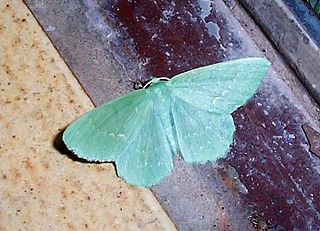
The large emerald is a moth which is the type species for the family Geometridae. It is found throughout the Palearctic region and the Near East in and around deciduous forests, heathlands, marshland and in settlements close to woodland. The species was first described by Carl Linnaeus in his 1758 10th edition of Systema Naturae.
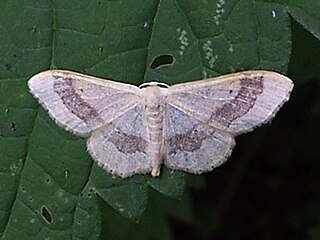
The riband wave is a moth of the family Geometridae. The species was first described by Carl Linnaeus in his 1758 10th edition of Systema Naturae.

The slender pug is a moth of the family Geometridae. It was first described by Jacob Hübner in 1813 and is found throughout Europe and western parts of the Palearctic. The larva feed on the catkins of willow.

The common wave is a moth of the family Geometridae. The species was first described by Giovanni Antonio Scopoli in his 1763 Entomologia Carniolica. It is found throughout the Palearctic region and the Near East.

The square-spot rustic is a moth of the family Noctuidae. It is found in Europe, North Africa and east across the Palearctic and in North America.

The common Quaker is a moth of the family Noctuidae first described by Johan Christian Fabricius in 1775. Some authors prefer the synonym Orthosia stabilis(Denis & Schiffermüller, 1775). It is distributed throughout Europe and is also found in Turkey, Israel, Transcaucasia, Russia and eastern Siberia.
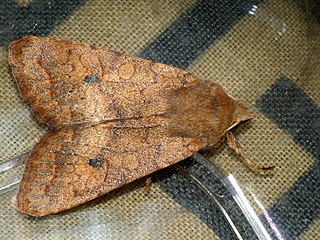
Agrochola circellaris, or The Brick, is a species of moth of the family Noctuidae. The species was first described by Johann Siegfried Hufnagel in 1766. It is distributed throughout most of Europe, Asia Minor and Armenia.

The angle shades is a moth of the family Noctuidae. The species was first described by Carl Linnaeus in his 1758 10th edition of Systema Naturae. It is distributed throughout Europe as far east as the Urals and also in the Azores, in Algeria, and in Asia Minor, Armenia, and Syria. It is strongly migratory.

Papilio clytia, the common mime, is a swallowtail butterfly found in south and southeast Asia. The butterfly belongs to the subgenus Chilasa, the black-bodied swallowtails. It serves as an excellent example of a Batesian mimic among the Indian butterflies.

Hylaea fasciaria, the barred red, is a moth of the family Geometridae. The species can be found in Central and North Europe, Urals, Caucasus, Altai and East Siberia.

Scopula imitaria, the small blood-vein, is a moth of the family Geometridae. It was first described by Jacob Hübner in 1799 and it is found throughout Europe and in North Africa.

Orthosia cruda, the small Quaker, is a moth of the family Noctuidae. It is found in Europe, Morocco, Algeria, Tunisia, Turkey, the Caucasus, Transcaucasia, Kazakhstan, Israel, Lebanon, Cyprus and Jordan.

Idaea straminata, the plain wave, is a moth of the family Geometridae. It is found in Europe including West Russia and Balkans.

Rhizedra lutosa, the large wainscot or Isle of Wight wainscot, is a species of moth of the family Noctuidae. It is native to the Palearctic realm. It has been introduced into eastern North America and is spreading.
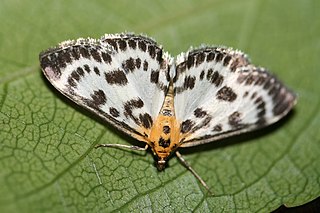
Anania hortulata, the small magpie, is a species of moth of the family Crambidae. It is found in Europe and North America.

Spilosoma lubricipeda, the white ermine, is a moth of the family Erebidae. It is found throughout the temperate belt of Eurasia from Europe through Kazakhstan and southern Siberia to Amur Region, China, Korea and Japan. In China several sibling species occur.
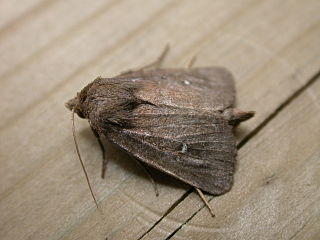
Archanara geminipuncta, the twin-spotted wainscot, is a moth of the family Noctuidae which is found in Europe, Lebanon, Israel, Turkey, Iraq and the Caucasus. The species was first described by Adrian Hardy Haworth in 1809.

Trabala vishnou, the rose-myrtle lappet moth, is a moth of the family Lasiocampidae. It is found in south-east Asia, including Pakistan, India, Thailand, Sri Lanka, Myanmar, Java, China, Japan, Taiwan, Hong Kong, Vietnam and Indonesia. Four subspecies are recognized.

Acraea natalica, the Natal acraea, is a butterfly of the family Nymphalidae. It is found from KwaZulu-Natal to Zimbabwe and in Mozambique, Malawi, Zambia, southern DRC (Katanga), Tanzania and eastern Kenya.

Tingena chloradelpha is a species of moth in the family Oecophoridae. It is endemic to New Zealand and can be found in the North and South Islands. The larvae live underground forming silken tubes from which it feeds. It overwinters in these tubes and then pupates enclosed in a weak pale white silken cocoon. The adults of this species is variable in appearance both in the depth of colour as well as in its discal spots which may in some specimens be lacking. The adults are on the wing from October until the end of December and can be found inhabiting domestic gardens as well as cultivated land. They have been seen resting on window frames and can be found inside houses.
























